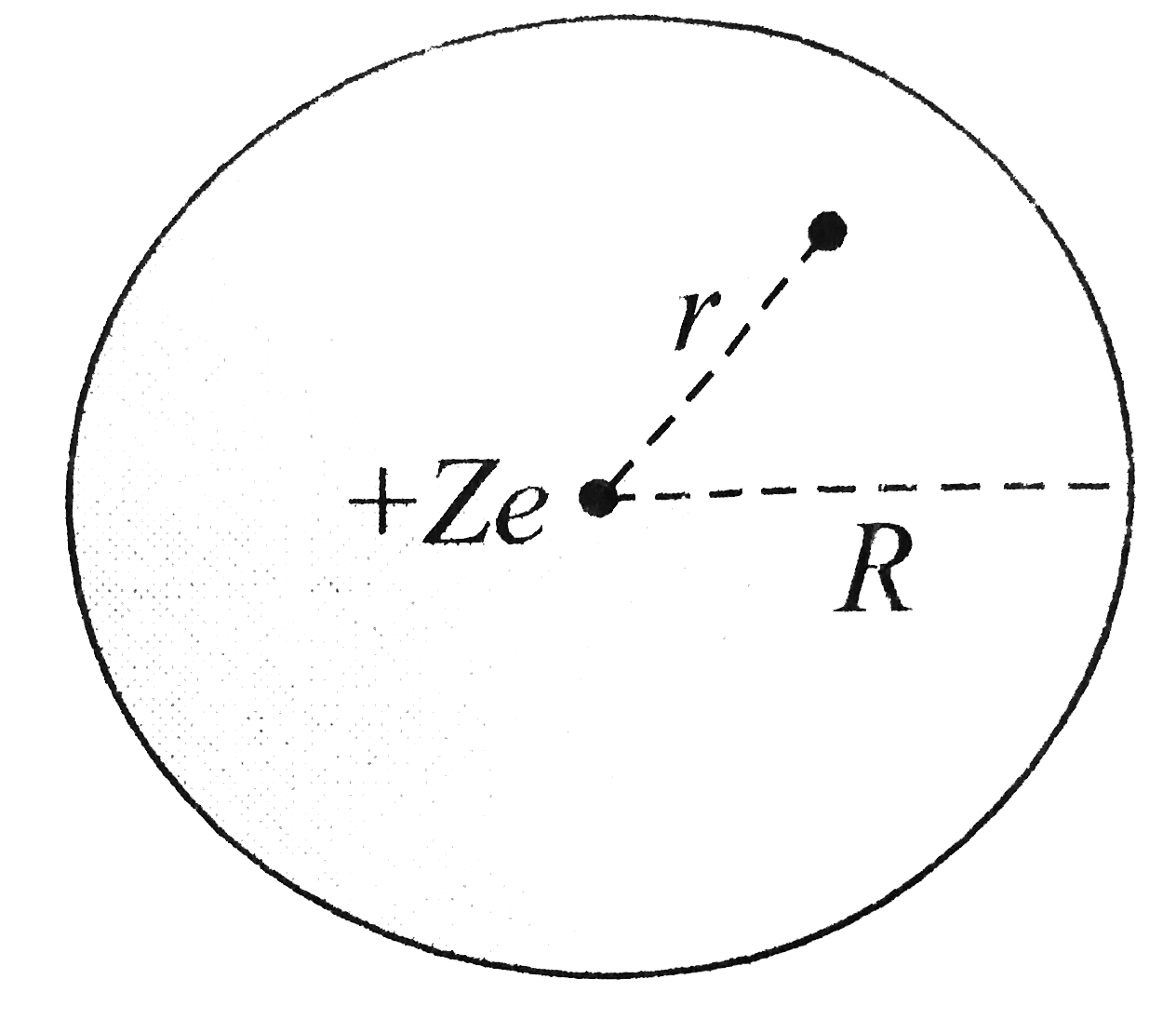An early model for an atom considered it to have a positively charged point nucleus of charge Ze, surrounded by a uniform density of negative charge upto a radius R. The atom as a whole is neutral. The electric field at a distance r from the nucleus is (r lt R)

Ze4πε0[1r2−rR3]
Ze4πε0[1r3−rR2]
Ze4πε0[rR3−1r2]
Ze4πε0[rR3+1r2]
The correct Answer is:A
Charge on nucleus is = + Ze
Total negative charge = -Ze
(∴ atoms is electrical neutral )
Negative charge density , ρ=chargevolume=−Ze43πR3
i.e., ρ=−34ZeπR3 ……….(i)
Consider a Gussian surface with radius r.
By Gauss's theorem ,
ϕ=E(r)×4πr2=qε0............(ii)
Charge enclosed by Gaussian surface
q'=Ze+4πr33ρ=Ze−Zer3R3 (Using (i))
From (ii),
E(r)=q'4πε0r2=Ze−Zer3R34πε0r2=Ze4πε0[1r2−rR3]
Topper's Solved these Questions
- ELECTRIC CHARGES AND FIELDSBOOK - NCERT FINGERTIPSCHAPTER - ELECTRIC CHARGES AND FIELDSEXERCISE - Electric Field Lines
12 Videos
- ELECTRIC CHARGES AND FIELDSBOOK - NCERT FINGERTIPSCHAPTER - ELECTRIC CHARGES AND FIELDSEXERCISE - Electric Flux
5 Videos
- ELECTRIC CHARGES AND FIELDSBOOK - NCERT FINGERTIPSCHAPTER - ELECTRIC CHARGES AND FIELDSEXERCISE - Electric Field
16 Videos
- DUAL NATURE OF RADIATION AND MATTER BOOK - NCERT FINGERTIPSCHAPTER - DUAL NATURE OF RADIATION AND MATTER EXERCISE - Assertion And Reason
15 Videos
- ELECTROMAGNETIC INDUCTIONBOOK - NCERT FINGERTIPSCHAPTER - ELECTROMAGNETIC INDUCTIONEXERCISE - Assertion And Reason
15 Videos
Similar Questions
According to early model of an atom,the atom is considered it to have a positively charged point nucleus of charge Ze surrounded by a uniform density of negative charge up to a radius R. The atom as a whole is neutral. The electric field at a distancer from the nucleus is (r<R)

View SolutionAccording to early model of an atom,the atom is considered it to have a positively charged point nucleus of charge Ze surrounded by a uniform density of negative charge up to a radius R. The atom as a whole is neutral. The electric field at a distancer from the nucleus is (r<R)

View Solution
Knowledge Check
According to early model of an atom, the atom is considered it to have a positively charged point nucleus of charge Ze surrounded by a uniform density of negative charge up to a radius R. The atom as a whole is neutral. The electric field at a distance r from the nucleus is (r<R)
 AZe4πε0[rR3−1r2]BZe4πε0[rR3+1r2]CZe4πε0[1r2−rR3]DZe4πε0[1r3−rR2]
AZe4πε0[rR3−1r2]BZe4πε0[rR3+1r2]CZe4πε0[1r2−rR3]DZe4πε0[1r3−rR2]An early model for an atom considered to have a positively charged point nucleus of charge Ze surrounded by a uniform density of negative charge up to a radius R. The atom as a whole is neutral. For this model, what is the electric field a distance r from the nucleus, where r>R ?
A14πε0Zer2B14πε0ZeR2C14πε0Zer2−R2D0A sphere of radius R has a charge density σ. The electric intensity at a point at a distance r from its centre is
AE=σR2∈0kr2BE=σ∈0kCE=R2DE=∈0kr2σ2
According to early model of an atom,the atom is considered it to have a positively charged point nucleus of charge Ze surrounded by a uniform density of negative charge up to a radius R. The atom as a whole is neutral. The electric field at a distancer from the nucleus is (r<R)

View SolutionAccording to early model of an atom,the atom is considered it to have a positively charged point nucleus of charge Ze surrounded by a uniform density of negative charge up to a radius R. The atom as a whole is neutral. The electric field at a distancer from the nucleus is (r<R)

View SolutionAn early model for an atom considered it to have a positivelly charged point nucleus of charge +Ze surrounded by a uniform density of negative charge up to a radius R. The atom as whole is neutral. For this model , what is the electric field at a distance r from the nucleus when
r<R
r=R ?Use Gauss's theorem
View SolutionState Gauss 'law in electrostatics.
Consider an overall neutral sphere of radius R. This sphere has a point charge +Q at its centre and this positive charge is surrounded by a uniform density ρ of negative charges up to a radius R.
Use Gauss, law to obtain expression for the electric field , of this sphere , at a point distant r, from its centre ,where
r<R,
r>R
Show that these two expressions give identical results, for the electric field, at r= R.
View SolutionIf the potential at the center of a uniformly charged sphere of radius R is V then electric field at a distance r from the center of sphere will be (r<R) : -

View Solution
